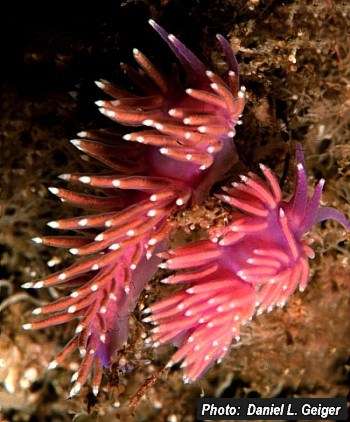
Flabellina pedata
(Montagu, 1815)
Order: NUDIBRANCHIA
Suborder: AEOLIDINA
Family: Flabellinidae
DISTRIBUTION
Mediterranean, and east Atlantic north to Norway.
PHOTO
Dun Village Bay,St. Kilda, Outer Hebrides, Scotland, United Kingdom, 1993, 15m. PHOTO: Daniel L. Geiger
Grows to about 50mm long. The body, oral tentacles and rhinophores are purple, and the tentacles and cerata are tipped with white. The colour of the digestive gland (and therefore the cerata) varies from red to pink, to violet and to orange. The rhinophores have a distinctly wrinkled surface. [See photo below]. Adults are usually found on their hydroid food Eudendrium ramosum but juveniles have been reported on a number of species of smaller calyptoblastic hydroids.
Reference:
• Montagu, G. (1815). An account of some new and rare British shells and animals. Transactions of the Linnean Society of London, 11: 179-204
Rudman, W.B., 1999 (June 16) Flabellina pedata (Montagu, 1815). [In] Sea Slug Forum. Australian Museum, Sydney. Available from http://www.seaslugforum.net/find/flabpeda
Related messages
Curious specimen of Flabellina pedata
March 26, 2008
From: Miquel Pontes
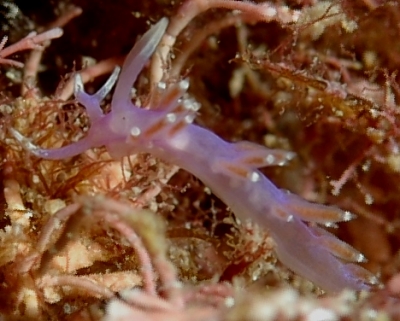
Dear Bill,
We came across this specimen of Flabellina pedata in our last dive. I was surprised to discover a bifurcated oral tentacle.
I don't know whether this is common or not, nor if it is a genetic anomaly that can be seen in other species, but I found it to be curious and wanted to share this with the forum readers.
Locality: Platja de Caials, Cadaqués, Costa Brava, 12 metres, Spain, Mediterranean Sea, 27 october 2007, Rocky precoraligen bottom. Length: 15 mm.. Photographer: Miquel Pontes.
Best regards
Miquel Pontes
http://marenostrum.org
info@marenostrum.org
Pontes, M., 2008 (Mar 26) Curious specimen of Flabellina pedata. [Message in] Sea Slug Forum. Australian Museum, Sydney. Available from http://www.seaslugforum.net/find/21044Thanks Miquel,
I assume it's a developmental abnormality, but surprisingly, if you look at the Abnormalities page. you will see we already have two examples of F. pedata with the same anomaly.
Best wishes,
Bill Rudman
Juvenile Flabellina ischitana vs F. pedata
May 30, 2007
From: Dominique Horst
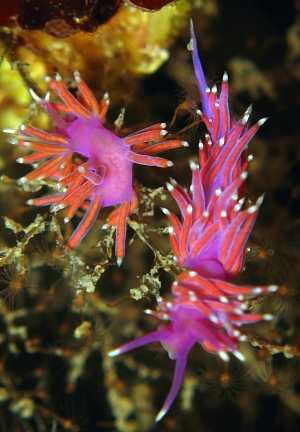
Hi Bill,
I have also difficulties to make a distinction between Flabellina pedata and Flabellina ischitana, especially for juveniles.
For adult specimens, rhinophores are very different and is a criteria of choice to distinguish the two species : F. pedata rhinophores are wrinkled and are ringed or circled in F. ischitana.
Locality: Cap d'Antibes, 20 m, France, Mediterranea, 23 August 2006, rocks. Length: 10 mm. Photographer: Dominique Horst.
But, when having juveniles like on pictures, the task is not easy ... I've a suggestion about the position of the cerata. For F. ischitana cerata are arranged in kind of cluster and for F. pedata the cerata are more in spaced ranks.
Not sure that this criteria is robust...
Any suggestion would be very appreciated.
Many thanks for your help
Best regards,
Dominique
dominique.horst@wanadoo.fr
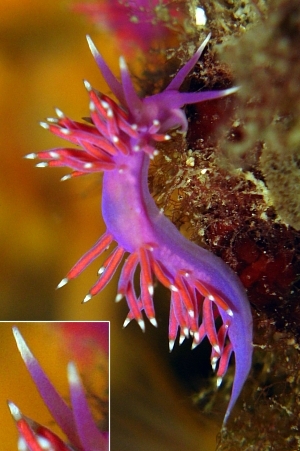
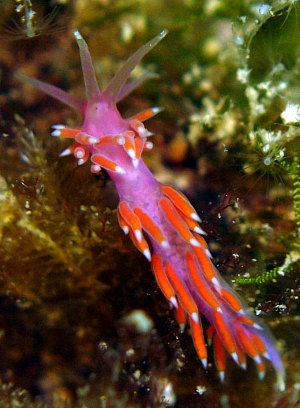
Dear Dominique,
I'm afraid I am not much help with the subtle differences between juvenile Flabellina. Sometimes if you have juveniles of similar species together in the field the differences appear quite obvious, but if you have only one species at a time the differences tend to disappear. However I would suspect an animal that was going to have ridges or rings or papillae on its rhinophores would have started to develop them by the time it was 10 mm long. Adult F. ischitana and F. affinis both have their cerata arranged on common 'trunks' or bases, while in F. pedata the cerata are arranged in rows, with each ceras separately inserting into the body wall. This would correspond with your suggestion that juveniles of F. pedata and F. ischitana would differ in ceratal arrangement. I suspect your animals here are all F. pedata.
My biggest problems with identifying your beautiful 'purple' Flabellina are between F. affinis and F. ischitana. Despite my best efforts I suspect some of the photos in the Forum are still misidentified.
Best wishes,
Bill Rudman
Flabellina pedata from Sweden
March 30, 2007
From: Bjarke Neidel
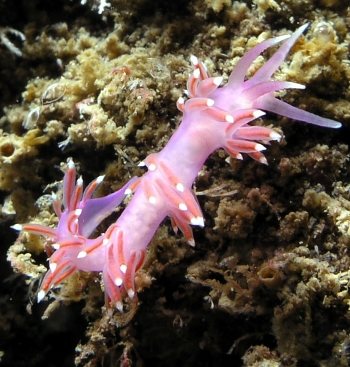
Concerning message #934:
Though this thread is quite old, I still fail to find any photos of the Coryphella pedata on this site. If you are still interested I have a shot that I am quite sure is of this species. It is taken of the Swedish west-coast.
Locality: Väderöarna, ~6 metres, Sweden, Skagerrak, 21 October 2006. Length: ~40 mm. Photographer: Bjarke Neidel.
Bjarke Neidel
bjarke.neidel@gmail.com
Neidel, B, 2007 (Mar 30) Flabellina pedata from Sweden. [Message in] Sea Slug Forum. Australian Museum, Sydney. Available from http://www.seaslugforum.net/find/19456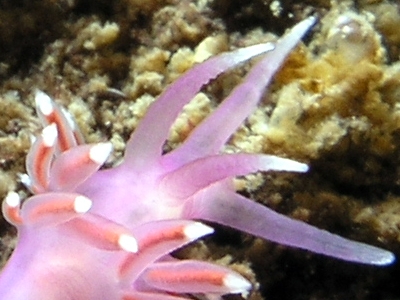
Dear Bjarke,
Thanks for the photo. As I mention in an earlier message [#1166], I follow most authors in considering Flabellina and Coryphella to be part of the same genus. There are quite a few photos of ' Coryphella' pedata on the Forum - as Flabellina pedata. If you can't find a name you are looking for in the Forum Species List then try the Forum Search box. Usually an old name like Coryphella pedata will be mentioned in an earlier message or a Fact Sheet so you should be able to trace what you are after. Another way, which I use all the time when I am looking for things on the Forum, is to search for the species part of the name - pedata - and see if it is present.
Best wishes,
Bill Rudman
Flabellina pedata with abnormality
March 30, 2007
From: Dominique Horst
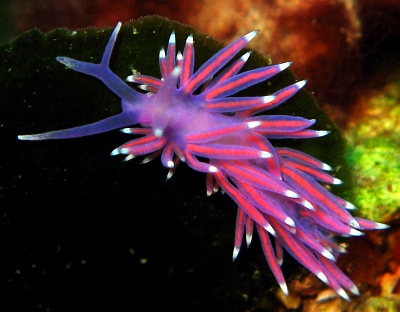
Dear Bill,
Another case of abnormality for the collection.
Flabellina pedata with a bifid oral tentacle
Locality: Cap d'Antibes, 25m, France, Mediterranean sea, 17 March 2007, rocks. Length: 30mm. Photographer: Dominique Horst.
Kind regards,
Dominique
dominique.horst@wanadoo.fr
Horst, D., 2007 (Mar 30) Flabellina pedata with abnormality. [Message in] Sea Slug Forum. Australian Museum, Sydney. Available from http://www.seaslugforum.net/find/19701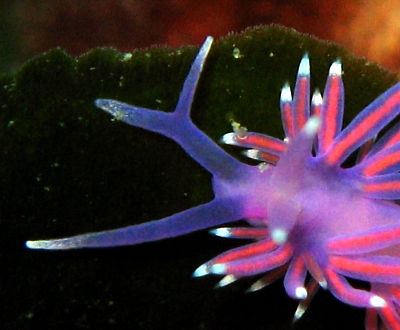
Thanks Dominique,
Best wishes,
Bill Rudman
Flabellina pedata from Turkey
August 19, 2003
From: Ferda Buyukbaykal
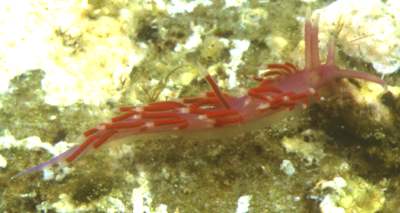
Dear Bill,
Is this Flabellina pedata ?.
Date: August 10, 2003
Location: Canakkale, Saroz
Site: Minnos kayalari
Depth: 10-12 mt
Size: 25-30 mm
Photos: Ferda Buyukbaykal
Best regards
Ferda
ferdabbaykal@isnet.net.tr
Buyukbaykal, F., 2003 (Aug 19) Flabellina pedata from Turkey. [Message in] Sea Slug Forum. Australian Museum, Sydney. Available from http://www.seaslugforum.net/find/10775Dear Ferda,
It's a bit hard to be sure without a closer look at the rhinophores, but I suspect your identification is correct
Best wishes,
Bill Rudman
Flabellina pedata from French Atlantic
June 26, 2003
From: Marina Poddubetskaia
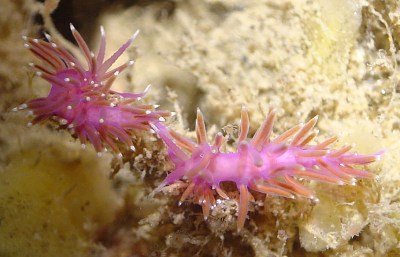
Dear Bill,
Flabellina pedata seems very common in Bassin d'Arcachon. Here is a shot of 2 animals from there.
Date: May 10, 2003
Location: Bassin d'Arcachon, France, Atlantic coast
Site: Hortense
Depth: 14m
Size: 20-25mm
Photos: Marina Poddubetskaia - Nembro website
Best wishes,
Marina.
nembro@nembro.info
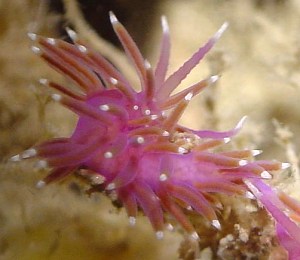
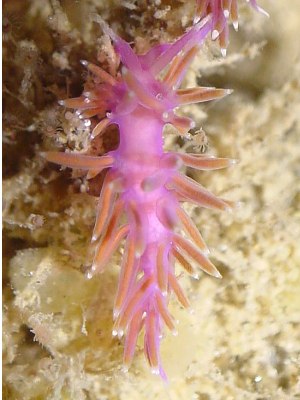
Thanks Marina,
Bill Rudman
Flabellina pedata from French Brittany
September 4, 2002
From: Marina Poddubetskaia
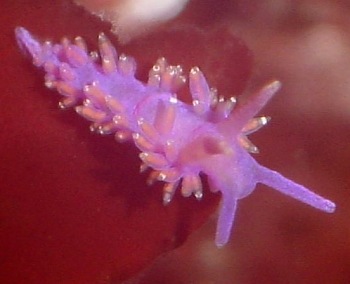
Dear Bill,
Here is a photo of Flabellina pedata from the Atlantic Ocean.
Date: August 17, 2002
Location: Belle-ile, Brittany, France. {Atlantic Ocean]
Site: La Cathedrale
Depth: 8m
Size: less than 1cm
Photo: Marina Poddubetskaia - Nembro website
Best wishes,
Marina.
nembro@nembro.info
Poddubetskaia, M., 2002 (Sep 4) Flabellina pedata from French Brittany. [Message in] Sea Slug Forum. Australian Museum, Sydney. Available from http://www.seaslugforum.net/find/7868Thanks Marina,
Bill Rudman
Deformed Flabellina pedata
August 8, 2002
From: Erwin Köhler
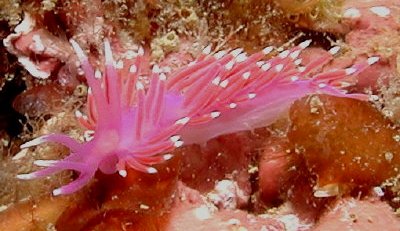
Dear Bill,
Here is one more for you Abnormalities page. A Flabellina pedata with two split oral tentacles, just looking like 4! It is from Spain, Roses, divesite "Cabo Trencat".
Size: 22mm
Depth: 14m
Date: 29 May 2002
Cheers,
Erwin
Erwin@medslugs.de
Köhler, E., 2002 (Aug 8) Deformed Flabellina pedata. [Message in] Sea Slug Forum. Australian Museum, Sydney. Available from http://www.seaslugforum.net/find/7711Thanks Erwin,
This page is showing us a much greater range of malformations than I had expected
Bill Rudman
Flabellina pedata from the Mediterranean
August 7, 2002
From: Marina Poddubetskaia
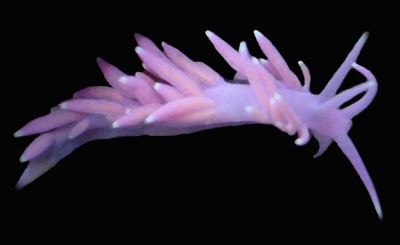
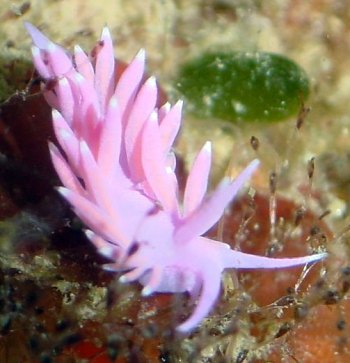
Dear Bill,
This Flabellina pedata was found during the 'Sea Slugs Training Course' in Cerbere and was identified by Jean-Pierre Bielecki. Flabellina pedata could be confused with Flabellina affinis or F. ischitana. According to Jean-Pierre, the sure way to distinguish it: F. pedata is the only one who has smooth or lightly wrinkled rhinophores (those of F. affinis and F. ischitana are lamellated).
I also think that this animal looks like my juvenile (which has smooth rhinophores) in my earlier message which you thought might be F. affinis.
Date : July 04, 2002
Location : Cerbere, France
Site : L'Ocell
Depth : 17m
Size : 10-15mm
Photos: Marina Poddubetskaia - Nembro website
Best wishes,
Marina.
nembro@nembro.info
Thanks Marina,
With groups of similarly coloured species, local knowledge is an important ingredient in correctly identifying species. Certainly the shape of the rhinophores is very useful in separating F. pedata from the other two species. As I said when discussing your earlier message, I couoldn't be sure in your juvenile whether the lack of lamellae on the rhinophores was because it was F. pedata or because it was a juvenile of one of the other two species and hadn't as yet developed lamellae. We just have to accept that sometimes a photo is just not enough for a proper identification.
Cheers,
Bill Rudman
Flabellina pedata? from French Mediterranean
June 29, 2002
From: Marina Poddubetskaia
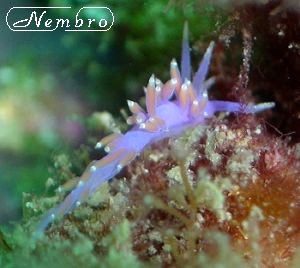
Dear Bill,
Could you help me to identify this Flabellina, please.
Date: June 04, 2002
Location: Cap Croisette (near Marseille), France
Site: Tiboulen de Maire
Depth: 18m
Size: less than 1cm
Best wishes,
Marina.
marina.poddubetskaia@orange-sc.com
Poddubetskaia, M., 2002 (Jun 29) Flabellina pedata? from French Mediterranean. [Message in] Sea Slug Forum. Australian Museum, Sydney. Available from http://www.seaslugforum.net/find/7342Dear Marina,
I suspect this is Flabellina pedata. It's hard to be sure with juveniles but the wrinkled rhinophores, and traces of white tips to rhinophores, oral tentacles and cerata seem to fit.
Best wishes,
Bill Rudman
Flabellina pedata and others? from Turkey (1)
October 27, 2001
From: Baki Yokes
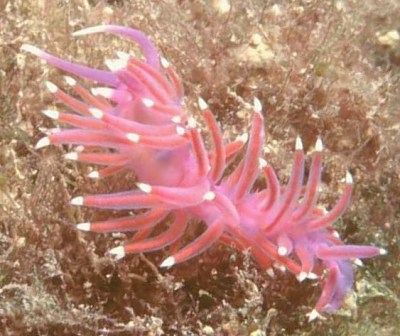
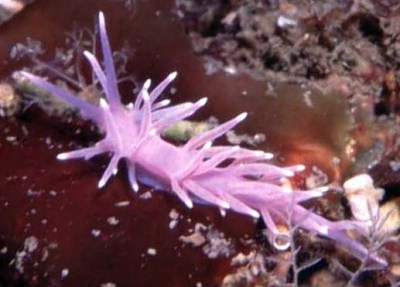
Hi,
I have photos of a number of different specimens that all look like Flabellina pedata to me. Are these also F. pedata?
UPPER RIGHT: Bodrum, Turkey. January 1997
Divesite: Big Reef, Depth: 14m, Size: 35mm.
LOWER RIGHT: Istanbul, Turkey. 7 October 2001. Divesite: Yassiada, Depth: 22m
Size: 25 mm
PHOTOS: Baki Yokes
Best regards
Baki
bakiyokes@turk.net
Yokes, B., 2001 (Oct 27) Flabellina pedata and others? from Turkey (1). [Message in] Sea Slug Forum. Australian Museum, Sydney. Available from http://www.seaslugforum.net/find/5359Dear Baki,
Some more very interesting photos. I have split your photos up into three separate messages. I think these two are probably Flabellina pedata. The rhinophores appear to be smooth and only the anterior cluster of cerata appear to have a common base or stalk.
In a separate message I have put a group of your photos I think are probably Flabellina ischitana, and in another message I have put a photo I can't identify with any certainty.
I would be grateful for some thoughts from some of you more familiar with the Mediterranean fauna.
Best wishes,
Bill Rudman
Flabellina pedata? from Spain
June 14, 2000
From: Erwin Koehler
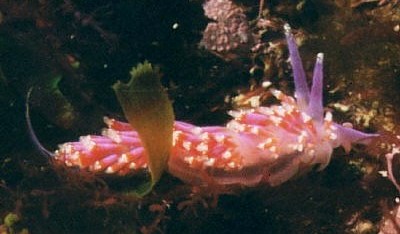
Dear Bill,
This one looks like Flabellina pedata, but I've never seen an individual with these white spots on the cerata and rhinopores.
It was found at 11m depth, total length of 21mm, divesite "La Trona", Cala Joncols, Spain, April 21, 2000.
Erwin
Medslugs.Koehler@t-online.de
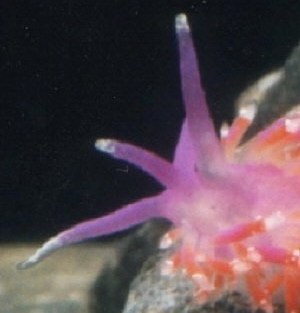
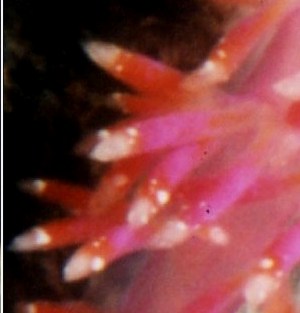
Dear Erwin,
The spots do look unusual. perhaps our Spanish friends can answer your question.
Best wishes,
Bill Rudman.
More photos of Flabellina pedata from Holland
August 12, 1999
From: Peter H. van Bragt
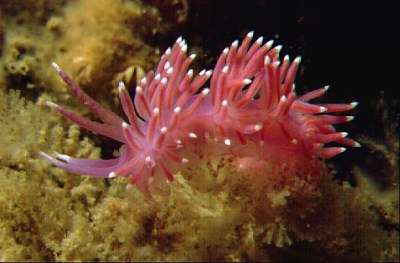
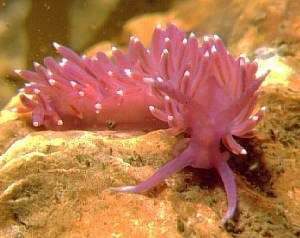
Dear Bill,
Here are two more photos of Coryphella pedata to add to the Netherlands' List.
Location: Plompe Toren, de Oosterschelde, the Netherlands
Met vriendelijke groeten
(With best regards)
Peter H. van Bragt
Peter.vanBragt@ftn.hsbrabant.nl
van Bragt, P.H., 1999 (Aug 12) More photos of Flabellina pedata from Holland. [Message in] Sea Slug Forum. Australian Museum, Sydney. Available from http://www.seaslugforum.net/find/1166Thanks Peter,
I am following most recent workers who consider Coryphella to be a synonym of Flabellina.
best wishes,
Bill Rudman.
Flabellina pedata from Holland
June 18, 1999
From: Peter H. van Bragt
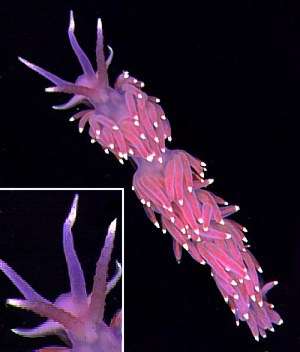
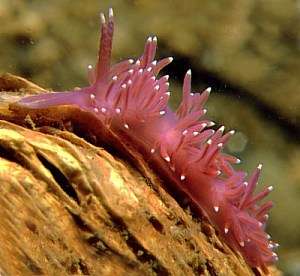
Hallo Bill,
Thank you for your Email.
I assume that you had a good time in Sicily. Did you manage to do any diving and good nudi spotting there??
Here in the Netherlands we have a small but rather active group of people involved in nudi spotting. Rob Dekker (Netherland Institute for marine research) coordinates a database for the the Dutch observations.
I myself am very active on collecting data for the database, but also in underwaterphotography. May be it is nice to put the following on the bulletin board as well:
On June 10, 1999 I have spotted a new species, Flabellina pedata, for the Dutch coast. It is a known species for the Atlantic coast, Adriatic and Mediteranean, but until now it was unknown in the Netherlands.
It was first found in the Oosterschelde at Plompe Toren (Burghsluis), the Netherlands, feeding on remains of Eudendrium sp.
Feel free to use the attached pictures for your site. [I have used 2 of the pics Peter sent me. UPPER: a studio shot of the first specimen recorded and LOWER: a specimen from another location in the Oosterschelde in the Netherlands -- Bill Rudman]
Keep up the good work with your Forum
Greetings from the lowlands
Peter H. van Bragt
Courses and ProjectManager
Training centre (TMB) & CTT
Faculty for Science and Technology
HogeschoolBrabant
Concordialaan 137, 4874 NS ETTEN-LEUR
P.O. Box 280 4870 AG ETTEN-LEUR
The Netherlands
Peter.vanBragt@ftn.hsbrabant.nl
Dear Peter,
Thanks for your comments and the pictures of Flabellina pedata. I think this is probably the correct identification for Xavier's species but without the specimen or a photo we can never be sure.
I'm afraid we didn't do any serious collecting in Sicily but it was a very good opportunity to meet up with colleagues, compare notes, exchange ideas etc.
Is the database you mention accessible on the web? If so I could put a link to it. If not I would be happy to put any images from Holland on the Sea Slug Forum as a reference collection for your diving colleagues.
Best wishes,
Bill Rudman.
Re: Mystery from Holland
June 16, 1999
From: Xavier Merlin
Hello again,
Judging the shape, the nudibranch we have seen ressembles more to be a Facelina coronata indeed rather than a Coryphella pedata.
Just the colors do not seem to fit.
Anyone can explain this ?
Xavier
Merlin, X., 1999 (Jun 16) Re: Mystery from Holland. [Message in] Sea Slug Forum. Australian Museum, Sydney. Available from http://www.seaslugforum.net/find/942Dear Xavier,
I have just got back from Italy - after 12 hours at Rome airport and 23 hours flying - and am forcing myself to stay awake to try and reset my biological clock. I have posted a picture of Flabellina pedata from Scotland.. perhaps that solves your problem?
Best wishes,
Bill Rudman.
Re: Mystery from Holland
June 10, 1999
From: Xavier Merlin
Hello,
The species was probably a Coryphella pedata.
A Dutch paper mentions the discovery already since January in our waters. You can see the article on: http://ns1.svm.nl/natwet/biologie/lesidee/slakken.htm (The article is in dutch). [NOTE: site url no longer valid ... Bill Rudman, Sept. 1999]
Does anyone have other pictures of this species? If you do, please email them to me.
More pictures might convince me it is the one we did see.
Xavier
xavier.merlin@ping.be
Merlin, X., 1999 (Jun 10) Re: Mystery from Holland. [Message in] Sea Slug Forum. Australian Museum, Sydney. Available from http://www.seaslugforum.net/find/934Re: Mystery from Holland
June 9, 1999
From: Peter H. van Bragt
Dear Xavier,
Over the last half year we have spotted Facelina coronata (also known as F. auriculata) on a few different dive sites in the Oosterschelde. Most have been seen at the Zeelandbrug, Zierikzee. In particular the last few months many have been seen, including spawning adults and many eggcases. This species was seen in 1991 (I think) for the first time in the Netherlands, The second observation was in November 1998 at Gorishoek, Tholen and from january 1999 on many where spotted at Zierikzee.
I have a strong feeling that your nudi is also a specimen of F. coronata.
I will send an image soon
Greetings
Peter H. van Bragt
peter.vanbragt@ftn.hsbrabant.nl
van Bragt, P.H., 1999 (Jun 9) Re: Mystery from Holland. [Message in] Sea Slug Forum. Australian Museum, Sydney. Available from http://www.seaslugforum.net/find/933Re: Mystery from Holland
June 8, 1999
From: xavier merlin
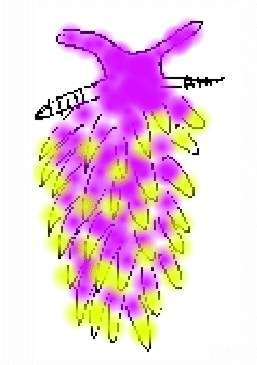
Hello again,
Flabellina ischitana at first glance looks like the one we have seen. However I believe that only the cnidosacs (top of the cerata) were yellow.Also the cerata were not that long and were far more numerous and tightly packed toghether.I will talk about it with my buddy to see what he recalls from memory. I have done lately 5 dives armed (same area)with camera but I failed to spot it again. It must be very rare.
I tried to draw a picture from memory. I will also ask my buddy if this is also what he recalls. It is just to give you an idea of the form and colors of what it looked like. There might have been far more numerous cerata than depicted in this drawing. Hope this helps. Details from memory are: Pink cerata, yellow cnidosacs, rhinophores? Depth: 5 metres. Size 4-5cm. Site; Welmedinge, Oosterschelde, Holland, 28 May, 1999. Drawing from memory.
xavier
xavier.merlin@ping.be
Merlin, X., 1999 (Jun 8) Re: Mystery from Holland. [Message in] Sea Slug Forum. Australian Museum, Sydney. Available from http://www.seaslugforum.net/find/929Re: Mystery from Holland
June 3, 1999
From: Xavier Merlin
Hello again,
For the shape, my unknown species resembles something in between Coryphella gracilis and Janolus cristatus, which are both nudibranches often seen here.
Only the colors, pink body and yellow cerata are the oddity.
I am off diving this weekend. This time with camera. I hope to find it again and to get a picture. If I have a picture, I will scan and forward it to you.
Meanwhile, any clues are welcome
Thank You,
Xavier
xavier.merlin@ping.be
Merlin, X., 1999 (Jun 3) Re: Mystery from Holland. [Message in] Sea Slug Forum. Australian Museum, Sydney. Available from http://www.seaslugforum.net/find/918Dear Xavier,
Good Luck with getting a photo. If you do, we should be able to help. In the meantime ideas from anyone are welcome.
Bill Rudman.
Mystery from Holland
June 2, 1999
From: Xavier Merlin
Hello,
I have no idea how to identify nudibranches. Last week I saw a beautiful nudibranch, pink in color with lots of yellow cerata. It was rather small, about 1 to 2 centimeters and oval in shape. I have never seen this nudibranch before. The dive site is at the "oosterschelde" which is an estuary of the North Sea in Holland. Such colour combination is quite unusual here. It looked like an exotic species to me.
Please give me some visual clues as to positively identify this beauty.
Thanks,
Xavier Merlin
xavier.merlin@ping.be
Merlin, X., 1999 (Jun 2) Mystery from Holland. [Message in] Sea Slug Forum. Australian Museum, Sydney. Available from http://www.seaslugforum.net/find/905Dear Xavier,
I think I am the one that needs some visual clues. I think I need a bit more information to visualise your animal. If it's not native to your region then it could conceivably be from any temperate region of the world. Your mention of cerata means you probably have an aeolid, but there are other opisthobranchs with cerata-like extensions on their bodies.
For example there are herbivorous sacoglossans like Costasiella and Stiliger.
Amongst the nudibranchs there are goniodorids, such as Hopkinsia and zephyrinids, such as Janolus, as well as the very diverse aeolids.
It would be best if you could send me a photo or even a drawing of the animal so that we had some idea of what we were making a guess about. If you have access to scanning facilities send me a scan or else post me a picture. I will return any photos.
Sorry I can't be of more help without more information,
Best wishes,
Bill Rudman.
